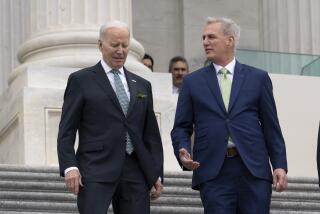Time’s Up for the Barely Ticking U.S. Debt Clock
NEW YORK — Time has run out for the National Debt Clock.
For more than a decade, the stark green sign has chronicled the second-to-second growth in the country’s debt from its perch atop a building near Times Square. Often the debt was rising so fast the last several numbers were blurred, reminding passersby of a serious economic problem usually expounded upon by pundits.
These days, the sign is hardly the clarion call it used to be. Its numbers barely budge, and the national debt has actually decreased since the beginning of the year, what with these strange phenomena of budget surpluses and the first buybacks of government debt in 70 years. So, the owners of the sign are pulling the plug.
Barring an unexpected reversal in Washington’s newfound sense of fiscal responsibility, the National Debt Clock will go dark Sept. 7, the birthday of the man who invented it, the late Manhattan developer Seymour Durst.
“It was put up to focus attention on the increasing national debt, and it’s served its purpose,” says Seymour’s son, Douglas Durst, who now runs the family real estate business.
“We’re obviously pleased that it was partially because of the sign that attention was focused on the debt and efforts were made to bring it under control,” Durst said.
Meanwhile Friday, the Congressional Budget Office said it expected the U.S. budget surplus will exceed $200 billion this fiscal year, up from its estimate of $179 billion.
The CBO, Congress’ budget analyst, said the portion of the surplus excluding Social Security reserves should top $40 billion, up from its $26 billion estimate for fiscal 2000 that ends Sept. 30.
The non-Social Security portion is the subject of national elections in November over how best to use surpluses to defray tax cuts, speed up payment of the national debt and meet spending priorities.
The forecasts, included in a monthly CBO report, were the first since experts evaluated April federal tax returns.
Tax returns “were unexpectedly strong,” the agency said, with the booming economy boosting receipts almost 1% higher this April than a year ago.
More to Read
Get the L.A. Times Politics newsletter
Deeply reported insights into legislation, politics and policy from Sacramento, Washington and beyond. In your inbox three times per week.
You may occasionally receive promotional content from the Los Angeles Times.










